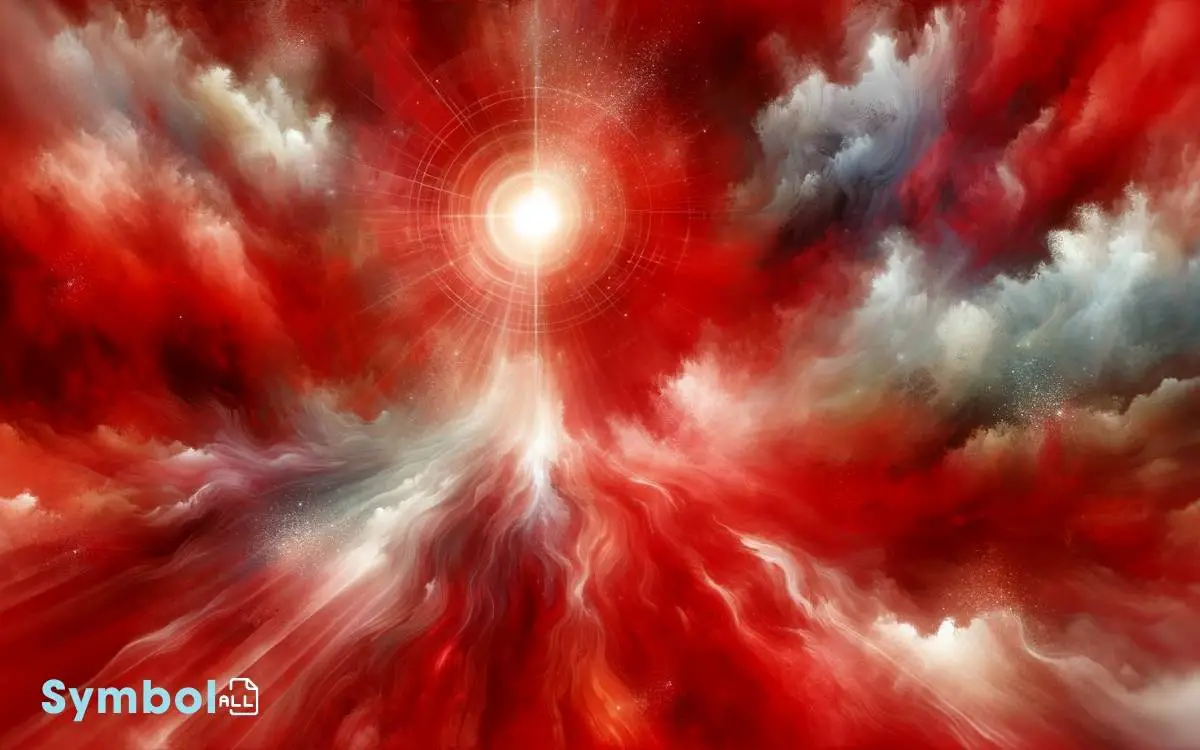What Does the Color Red Symbolize Spiritually? Explained!
Spiritually, you’ll find that red is a powerful symbol of passion, embodying deep emotions from love to anger. It stands for courage and valor, injecting bravery into hearts and historical tales alike.
Red pulsates with vitality, marking itself as the hue of life energy and creativity. It also serves as a universal sign of danger and warning, alerting you to tread carefully. On a grounding note, red connects you to the Earth, offering stability in tumultuous times.
Additionally, it symbolizes transformation and renewal, capturing the essence of change and new beginnings.
Exploring this color further reveals its multifaceted significance across cultures and personal interpretations.

Key Takeaway
The Essence of Passion
Red often embodies the intensity of passion, capturing emotions that range from love to anger with its vivid hue.
You’ll find that in many cultures, red isn’t only a signifier of deep affection but also of fervent emotionality, including both positive and negative aspects.
This duality allows red to communicate a wide spectrum of feelings, making it a powerful tool in symbolic language.
Its presence in rituals, attire, and art underscores its capacity to evoke and express the depths of human experience.
Analyzing its usage across different contexts reveals how universally red is associated with the heart’s most profound stirrings.
Hence, when you encounter red in any cultural artifact or natural setting, it’s inviting you to ponder the passionate undercurrents that define much of human interaction.
A Symbol of Courage
Throughout history, society’s valor has often been symbolized by the color red, embodying the essence of courage in the face of adversity.
This vibrant hue signals a primal call to arms, stirring the spirit and rallying individuals to confront challenges with bravery.
Red’s association with courage isn’t random; it’s deeply rooted in human psychology and cultural narratives.
In many traditions, red is the color of warriors, heroes, and martyrs who’ve laid down their lives for their causes. It represents not just physical bravery, but also the moral strength to stand up for one’s beliefs.
Consequently, red transcends mere visual stimulation. It acts as a beacon of fortitude, encouraging you to persevere through trials with unwavering determination.
Energies of Vitality
Beyond symbolizing courage, the color red also embodies dynamic energies of vitality, invigorating your senses and igniting a zest for life.
This vibrant hue is deeply associated with life force and creativity, acting as a catalyst for action and passion.
In spiritual contexts, red is often seen as a beacon of energy, encouraging movement and progress.
Key aspects associated with red’s vitality include:
- Stimulation of physical energy, enhancing alertness and physical endurance.
- Fostering creativity, by stimulating emotions and thoughts.
- Encouragement of confidence and assertiveness, helping individuals to take action.
Through its association with the root chakra, red is believed to ground individuals, providing a sense of security that fuels both physical and spiritual vitality. Its energizing presence is a constant reminder of the pulsating life force within and around us.
Danger and Warning
You’ve seen how red symbolizes vitality; now, let’s explore its association with danger and warning.
The color red triggers alert signals and an instinctual fear response, serving as a universal caution in various contexts.
This reaction isn’t only deeply ingrained in human psychology but also pivotal in how societies design safety signals.
Alert Signals Interpretation
In the domain of alert signals, the color red stands as a universal symbol for danger and warning, shaping human behavior and responses across various contexts.
You’re likely familiar with its use in traffic lights, signaling the need to stop, and in warning signs indicating potential hazards.
This widespread adoption isn’t guaranteed; it’s rooted in the color’s ability to quickly grab attention and convey a sense of urgency.
- Traffic signals use red to denote stop, leveraging its visibility and association with caution.
- Hazard symbols often feature red to guarantee they’re noticed immediately, even from a distance.
- Emergency services utilize red in their vehicles and attire to indicate urgent assistance is needed or underway.
This strategic application of red underscores its effectiveness in alerting individuals to potential dangers, guiding them to respond appropriately.
Instinctual Fear Response
The human brain instinctively associates the color red with danger, triggering an immediate fear response that serves as a primal warning system. This reaction is not merely a cultural construct but is deeply embedded in our evolutionary past.
Red often signifies the presence of a threat, be it from predators or poisonous substances, compelling us to act swiftly to avoid harm.
Understanding this instinctual response to red enhances your appreciation of its use in various contexts, emphasizing the importance of color in human survival and decision-making processes.
Connection to the Earth
You observe that the color red embodies grounding energies, enhancing one’s connection to the Earth. Its association with vitality and passion further underscores the profound interplay between human emotions and the natural world.
This connection invites a deeper understanding of how colors influence our perception of environmental and personal well-being.
Grounding Energies
Red’s vibrant hue often symbolizes its deep connection to the earth’s grounding energies, offering a foundation of stability and strength.
This connection isn’t merely metaphorical; it’s steeped in a long history of cultural significance and spiritual symbolism.
Red, as a color, acts as a conduit for the grounding energies of the earth, providing not just a sense of physical presence but also a spiritual anchor.
- *Red encourages a feeling of safety and security.*
- *It fosters a deeper connection with the natural world.*
- *The color aids in grounding the spirit during times of turmoil or uncertainty.*
Understanding this aspect of red’s symbolism can deepen your appreciation for its presence in spiritual practices and its use in meditative or healing environments. It’s not just a color; it’s a bridge to the earth’s stabilizing energies. It serves as a grounding force, reconnecting individuals to their root essence and fostering resilience and balance in times of uncertainty. The color red meaning in The Giver can also evoke a sense of vitality and intensity, mirroring its broader symbolism of passion and life force. This duality of grounding and energizing qualities makes red a powerful tool for both introspection and empowerment.
Vitality and Passion
Capturing the earth’s life force, red embodies an intense passion that stimulates both the physical and emotional worlds of human experience.
This vivid hue serves as a conduit, channeling the raw energy and vitality that pulsate within the earth’s crust into our daily lives.
It’s as if the color red translates the planet’s vigorous heartbeat into a visually perceptible form, reminding you of your own innate power and zest for life.
In spiritual practices, red’s association with vitality and passion isn’t merely symbolic; it’s believed to enhance one’s connection to the primal forces of nature, fostering a sense of groundedness and resilience.
Fires Intense Spirituality
In many cultures, red symbolizes a powerful connection to spirituality, often representing the fervor and intensity of spiritual pursuits.
This vibrant hue is deeply entrenched in rituals and practices that aim to elevate the human spirit to higher spheres of understanding and enlightenment.
- Transformation: Red is often seen as the color of spiritual metamorphosis, signifying the shedding of old ways for new enlightenment.
- Protection: In spiritual contexts, red acts as a barrier against negative energies, offering a shield to those on a spiritual journey.
- Sacrifice: It embodies the ultimate sacrifices made in the pursuit of spiritual depth, including the relinquishing of material possessions and ego.
Understanding red’s role in spirituality involves recognizing its capacity to both energize and protect, serving as a catalyst for profound spiritual growth and transformation.
Loves Deep Red
You observe that the color red often symbolizes the depth and intensity of love, serving as a vibrant expression of passion.
It’s not just an arbitrary association; red’s connection to love enhances the perception of heartfelt connections, making it a universally recognized symbol in this regard.
This relationship between red and love’s expressions invites further exploration into how color psychology influences human emotion and connection.
Passions Vibrant Expression
Red’s deep hues often serve as a vivid symbol for passion and love, embodying the intensity and depth of these emotions.
This vibrant color not only captures the essence of strong feelings but also communicates them in a way that’s universally understood.
When you encounter red in spiritual or symbolic contexts, it’s often inviting you to explore the depths of your own passions.
- Evokes Strong Emotions: Red stimulates feelings intensely, pushing boundaries of comfort and familiarity.
- Symbolizes Desire: It represents a longing or craving, whether for a person, goal, or experience.
- Encourages Action: Beyond feeling, red compels movement towards what one is passionate about, urging you to pursue what sets your heart aflame.
Heartfelt Connections Enhanced
Building on the vibrant expression of passions, it’s imperative to explore how red fosters deep, heartfelt connections between individuals.
This hue, often associated with love and desire, transcends superficial attractions to embody the essence of profound, emotional bonds.
In various cultures, red symbolizes the heart—the core of life and love—highlighting its role in enhancing connections that aren’t only romantic but also platonic and familial.
It’s through this lens that one can appreciate red’s capacity to deepen empathy, foster mutual understanding, and encourage a shared sense of belonging.
Analyzing its influence, red’s vibrant energy doesn’t just ignite passion; it nurtures the kind of love that sustains and enriches relationships, making it a powerful symbol in fostering heartfelt connections.
Power and Dominance
In cultures around the world, the color red often symbolizes power and dominance, influencing perceptions and behaviors in social and political contexts.
You’ll find that this vibrant hue carries a profound significance, shaping how individuals and groups interact with and perceive authority.
- Red commands attention: It’s a color that’s hard to ignore, often used to signal authority or status.
- Association with leadership: Many leaders and influential figures wear red to denote power and confidence.
- Impact on perception: Red can make individuals appear more dominant and powerful to others.
This color’s role in symbolizing power isn’t just a matter of tradition or superstition; it’s deeply embedded in human psychology and societal structures. Understanding its impact can offer insights into social dynamics and personal influence.
Sacrifice and Salvation
Beyond its associations with power and dominance, red also deeply resonates with themes of sacrifice and salvation across various cultures.
This color often symbolizes the blood shed by martyrs, encapsulating both the ultimate sacrifice and the promise of redemption.
In Christian theology, red is emblematic of Christ’s blood, which was shed for the salvation of humanity.
Similarly, in many Indigenous traditions, red is considered sacred and represents the life force sacrificed for renewal and spiritual purity.
This dual symbolism underscores a profound truth across belief systems: that from sacrifice emerges the possibility of salvation.
Therefore, red’s spiritual significance transcends its visual impact, embodying the deep, sacrificial acts that lead to spiritual renewal and salvation.
Anger and Aggression
Red’s vibrant hue often embodies intense emotions, notably anger and aggression, reflecting its profound psychological impact.
This color’s association with anger isn’t arbitrary; it’s deeply rooted in human psychology and cultural interpretations.
When you see red, your body might react instinctively, preparing for conflict or flight, a sign of its powerful influence on human emotion.
To understand red’s connection to anger and aggression, consider the following:
- Psychological studies suggest that red can increase heart rate and adrenaline, contributing to feelings of aggression.
- Cultural symbolism varies, but red often marks territories or signals a warning, invoking a sense of danger.
- Historical usage shows red in flags and emblems during conflict, symbolizing strength and defiance.
Analyzing red through these lenses reveals its complex relationship with anger and aggression, emphasizing its role in expressing and evoking these potent emotions.
Life Force and Blood
You encounter the color red not just as a symbol of aggression but also as a representation of life force and blood, which are fundamental to human existence.
This color embodies vitality and energy, reflecting the dynamic nature of life itself. Moreover, it connects us to our ancestors, serving as a reminder of the enduring bond through generations, underscored by the shared lifeblood.
Vitality and Energy
The color red universally symbolizes dynamism and vigor, encapsulating the essence of life force and blood.
This vibrant hue conveys an unspoken energy, igniting a sense of strength and resilience within.
Red’s association with blood ties it directly to our very existence, indicating not just survival but flourishing life. It’s this intrinsic connection that positions red as a powerhouse of vitality and energy in spiritual symbolism.
To understand its impact, consider these aspects:
- Red stimulates physical energy, awakening our senses and encouraging action.
- It represents the life-giving force of blood, essential for vitality.
- Its vibrancy is a call to action, inspiring movement and passion.
In essence, red’s spiritual symbolism is deeply tied to its ability to embody and stimulate life force, making it a color of profound energy and vitality.
Ancestral Connections
Building on its importance in energy and vigor, red also embodies deep ancestral connections through its representation of life force and blood.
This vivid color serves as a symbol of our primordial ties, reminding us of the shared bloodline that links generations.
It’s not just a marker of physical heritage but also a metaphor for the spiritual and emotional bonds that form the fabric of familial relationships.
Through its association with blood, red encapsulates the essence of life itself, underscoring the continuity and the unbreakable bond between ancestors and descendants.
This connection fosters a sense of belonging, grounding you in a lineage that transcends time. Therefore, red’s spiritual symbolism extends beyond individual existence to encompass the collective journey of kinship and heritage.
Cultural Interpretations
Across various cultures, red embodies a spectrum of meanings, from passion and danger to prosperity and celebration.
This vivid color’s significance is deeply rooted in historical, religious, and social contexts, making it a powerful symbol worldwide.
In Chinese culture, red is synonymous with good fortune and joy, often used in festivals and wedding ceremonies to attract positive energy.
Native American traditions see red as a color of sacredness, representing the earth, life, and the east direction.
In Western societies, red can signify love and desire, but also danger and warning, indicating its dual nature.
You’ll find that red’s interpretation varies greatly, yet it consistently holds deep, symbolic value. Understanding these cultural nuances enriches your appreciation of red’s spiritual symbolism, allowing you to grasp its multifaceted nature.
Transformation and Renewal
Exploring the color red, it’s important to acknowledge how it symbolizes change and renewal, providing deep insights into its dynamic essence.
This vibrant hue captures the essence of life’s perpetual cycle of beginning and end, embodying the fiery energy necessary for change.
In spiritual contexts, red often marks significant shifts, suggesting not just an end but a rebirth, a shedding of old for the new.
It’s seen in nature as seasons change, leaves turning red before they fall, signaling an end and a promise of renewal.
This color’s association with both the rising and setting sun further underscores its role in symbolizing daily renewal and the transformative power of beginnings and endings.
Red’s ability to represent such profound concepts makes it a powerful symbol in spiritual and philosophical discussions.
The Call to Action
Red not only symbolizes transformation and renewal but also serves as a compelling call to action, urging individuals to engage and react.
This hue, vibrant and full of energy, inherently demands attention. It’s the color of stop signs, alert signals, and emergency vehicles, universally recognized for its assertive presence.
In a spiritual context, red’s call to action transcends the physical, encouraging personal empowerment, courage, and initiative.
- Empowerment: Red inspires you to take control of your life’s direction.
- Courage: It bolsters your bravery to face challenges head-on.
- Initiative: Red motivates you to start new ventures or paths with confidence.
Understanding red’s role as a call to action can guide you in harnessing its energy for personal growth and transformation.
Conclusion
To sum up, like a phoenix rising from ashes, red embodies a spectrum of profound meanings, from igniting passion to signaling caution. It’s the heartbeat of courage, a whisper of vitality beneath your skin.
Through cultural lenses, its hues paint stories of life, earth, and spiritual rebirth, urging you to heed its call.
Analyzing red’s rich tapestry reveals a universal truth: it’s not just a color, but a narrative of transformation, urging us towards action and renewal.






